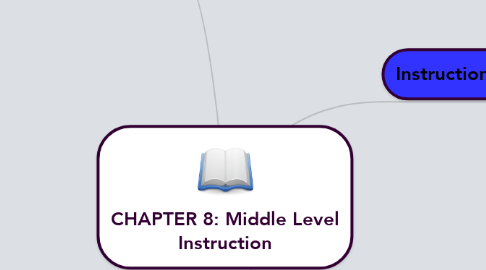
1. Big Ideas of Instruction
1.1. 1) Brain-Based Learning
1.1.1. Each brain is unique.
1.1.2. The brain processes what it hears, sees, and senses at the same time.
1.1.3. Learning involves the whole person.
1.1.4. Learning occurs in focused and peripheral ways.
1.1.5. We understand and remember best when facts and skills are embedded in experiences.
1.1.6. Challenge enhances learning; threat inhibits it.
1.2. 2) Student-Focused Instruction
1.2.1. Active student engagement
1.2.2. Variety of strategies
1.2.3. Student choice
1.2.4. Student inquiry
1.2.5. Student responsibility
1.2.6. Built-in, ongoing assessment of learning
1.3. 3) Backward Design
1.3.1. Stage 1: Involves identifying desired results
1.3.2. Stage 2: Involves determining what evidence will tell us if results were reached
1.3.3. Stage 3: Planing learning experiences and instruction with the results in mind
1.4. 4) Differentiation of Instruction
1.4.1. Content
1.4.2. Process
1.4.3. Product
1.5. 5) Thinking Skills (Bloom's Taxonomy)
1.5.1. Remember
1.5.2. Understand
1.5.3. Apply
1.5.4. Analyze
1.5.5. Create
1.5.6. Evaluate
1.6. 6) Inquiry-Based Learning
1.6.1. Constructivism
1.7. 7) Cooperative Learning
1.7.1. Positive Interdependence
1.7.2. Face to Face Interaction
1.7.3. Individual Accountability
1.7.4. Interpersonal Skills
1.7.5. Group Processing
1.8. 8) Technology in the Classroom
2. Reflections on Instruction
3. Instructional Strategies
3.1. 1) The Importance of Choice
3.2. 2) Nine Categories of Instruction
3.2.1. 1) Identifiying similarities and differences
3.2.2. 2) Summarizing and taking notes
3.2.3. 3) Reinforcing effort and providing recognition
3.2.4. 4) Homework and practice
3.2.5. 5) Nonlinguistic representations
3.2.6. 6) Cooperative learning
3.2.7. 7) Setting objectives and providing feedback
3.2.8. 8) Generating and testing hypotheses
3.2.9. 9) Cues, questions, and advance orgnaizers
3.3. 3) Recommended Strategies
3.3.1. Lecture
3.3.2. Demonstration
3.3.3. Think aloud
3.3.4. Questioning
3.3.5. Class discussions
3.3.6. Brainstorming, KWL
3.3.7. Notetaking
3.3.8. Drill and practice
3.3.9. Graphic organizers
3.3.10. Enhancing vocabulary
3.3.11. Sharing vocabulary
3.3.12. Role play
3.3.13. Projects
3.3.14. Jigsaw
3.3.15. Learning Centers
3.3.16. ThinkPairShare
